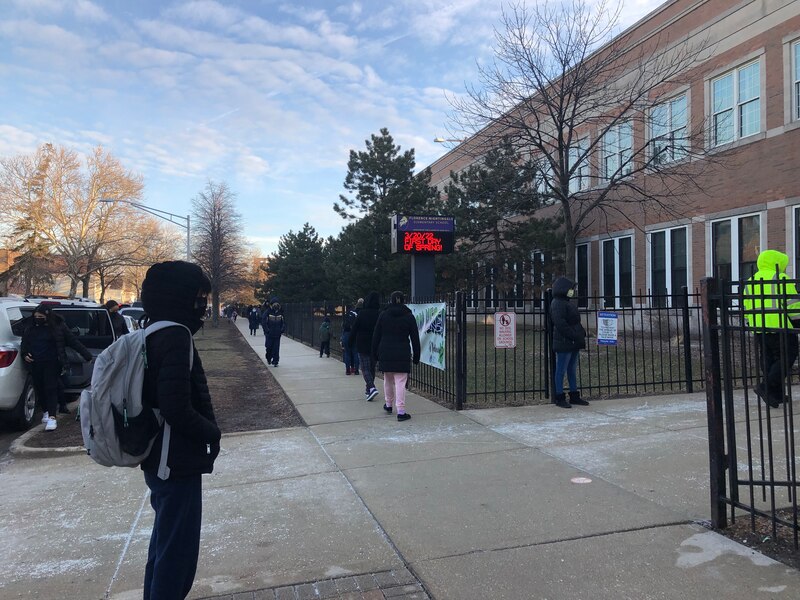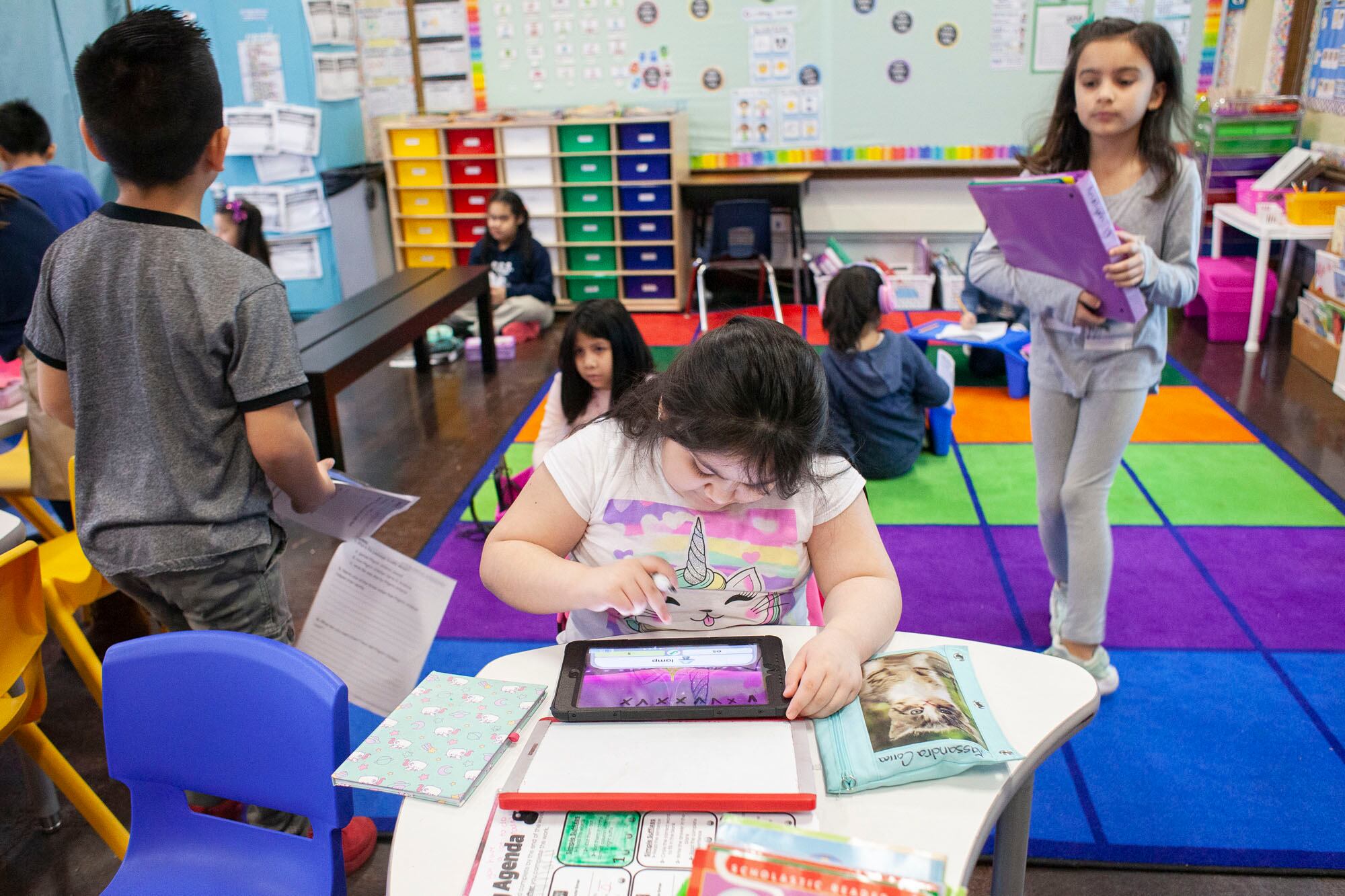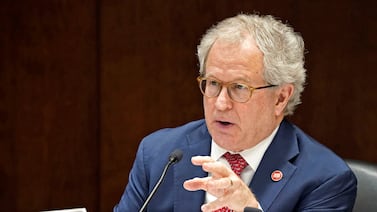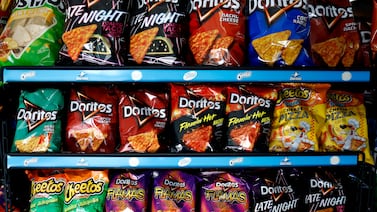For the first time in roughly two years, students in Chicago Public Schools were not required to wear masks on campus Monday morning. But that doesn’t mean the end of debates about masks.
For some families, the end of the mask mandate brought anxiety. Others welcomed it as a milestone on the way to normalcy amid the pandemic.
The district’s change in mask policy comes as federal, state, and local guidance have aligned. The Centers for Disease Control and Prevention late last month said schools could drop masks unless COVID cases and hospitalizations in the community were high.
“CPS was one of the first to require universal masking in schools, and we would not be moving to a mask- optional model unless the data and our public health experts indicated that it is safe for our school communities,” CEO Pedro Martinez said last week. “We will support our staff and students as we enter this new phase in the pandemic and continue to move forward together.”
At Florence Nightingale Elementary on the Southwest Side, many children still entered the campus wearing face coverings.
Clarita Salas adjusted her daughter’s mask before saying goodbye near the entrance to the school. She said for now, her second- and sixth-grade daughters would keep their mask on.
“I prefer that my kids continue wearing their masks,” parent Clarita Salas said in Spanish, “because you might have a child without a mask pass the virus to the other kids in their class.”
But at Kinzie Elementary, also on the Southwest Side, Robyn Peterson, the mother of a kindergartener, said the end of the district’s mask mandate comes as a relief to her family. She said her child took a month to get used to wearing a mask at school, which has felt arbitrary at times given unmasked school meals and afterschool playtime with classmates.
Peterson’s daughter went to school without a face covering on Monday morning, joining some masked and some unmasked peers.
“This was the easiest decision I have ever made,” she said.
The district will continue its school-based COVID testing and quarantine policy. Students who test positive will have to quarantine for five days and then wear a mask for five days after returning to school, officials said.
Last week, Dr. Allison Arwady, the city’s health commissioner, and Martinez said the school mask mandate could return should cases begin to climb, but they didn’t provide a metric for when they would move to reintroduce masks on school campuses.
The sudden change in Chicago’s mask policy — just weeks after the Chicago Board of Education voted to affirm its commitment to masks and other COVID mitigation strategies — has prompted swift criticism from the teachers union, which said the district violated a safety agreement the district and union signed in January.
The agreement was forged after district officials canceled five days of classes when teachers walked out over safety concerns amid the rise of COVID-19 cases across the city
The union has filed an unfair labor practice complaint that is being investigated by the Illinois Educational Labor Relations Board. Union leaders said dropping the mask mandate would put students and staff in danger, especially at South and West Side schools where a push to vaccinate students appears to have stalled.
About 49% of students from 5 to 17 are vaccinated, but three dozen schools on the South and West Sides had fewer than 10% of their students fully vaccinated. And more than 470 schools had less than 50% of students fully vaccinated as of March 3, according to data obtained by Chalkbeat Chicago.
Across the district, about 47% of 5- to 11-year-olds and 64% of 12- to 17-year-olds have received at least one dose of the COVID vaccine, according to the district’s latest figures.
On Monday, the Chicago Teachers Union and some educators took to social media to advocate for continued mask wearing, tweeting with the hashtag #maskingforafriend.
‘A teaching moment for my kids’
For Sheila Vogt, low COVID case and transmission rates, the omicron’s lower risk of serious complications, and higher vaccination rates mean it might be time to relax some pandemic rules, including universal masking.
The mom of a kindergartener and a seventh grader, she shares concerns that mask-wearing in classrooms has affected young learners’ development.
However, Vogt believes the district should empower Local School Councils to make decisions about universal masking that make sense for their school communities. At Edison Regional Gifted Center, her seventh grader’s North Side school, almost 90% of students are vaccinated. The school is small, clean, and diligent about COVID mitigation measures, so going mask-optional feels safe.
But, Vogt said, “The schools in this city are so different. A one-size-fits-all policy doesn’t seem appropriate.”
On Monday, Vogt’s children headed to school with their masks on. The family still feels the slight discomfort of masking is worth the reduced risk of getting sick or transmitting the virus to others. She said she worries her children might feel alienated if a lot of their classmates go maskless.
“But I also see this as a teaching moment for my kids — that we need to do what we believe in, even when it’s hard or others make us feel bad,” she said.
Rosalyn Walker, a South Side parent whose son attends LaSalle Language Academy on the North Side, strongly disagreed with the district’s decision to go mask-optional.
Last Thursday, she rushed to LaSalle after her seventh grader asked to be picked up when his classmate had tested positive for COVID — the third case in the classroom that week and the fourth schoolwide.
Walker, who serves on LaSalle’s Local School Council, knew her son would have a math test the following day, and she tried to persuade him to stick around until that Thursday’s math class, to review material for the exam. But he insisted on leaving right away.
She greeted the district’s decision to stop requiring face coverings by donating KN95 masks to her school.
Her son, who tested negative last week, headed to school Monday feeling on edge. But she reassured him that his vaccine, booster shot and mask would give him solid protection — even if classmates, some of whom have been pulled down their masks in defiance of the rule already, ditch the face coverings altogether.
“If you keep the mask on, it will continue to do its job,” she told him.

Outside Florence Nightingale, where 42% of students are fully vaccinated and 61% of the students have at least one dose of the vaccine, Andrea Hernandez said she was OK with the change in policy. Hernandez wore her mask, but said her daughter, who is vaccinated, didn’t want to wear her mask.
“She didn’t want to use it anymore,” Hernandez said.
Still, most parents at the school accompanied their children who were mostly masked to one of the school’s entrances.
Parent Martha Sandoval said her two daughters would continue to wear their masks until they see what kind of impact the shift in mask policy will have on COVID-19 cases.
“What I’m seeing is that the majority of people are still sending their kids with masks,” Sandoval said.
Maribel Martinez feels as though the district changed its policy due to political pressure from people who no longer see COVID as a threat.
But in a working-class neighborhood that has been hard hit by COVID, Martinez said it’s still very much a threat. For the time being, Martinez said she is making sure her 8-year and 12-year-old daughters continue wearing their masks to protect everyone in the family.
“We have an option so I’m choosing my kids to keep their masks on,” Martinez said, “because COVID is still out there.”
Mauricio Peña is a reporter for Chalkbeat Chicago, covering K-12 schools. Contact Mauricio at mpena@chalkbeat.org.
Mila Koumpilova is Chalkbeat Chicago’s senior reporter covering Chicago Public Schools. Contact Mila at mkoumpilova@chalkbeat.org.





